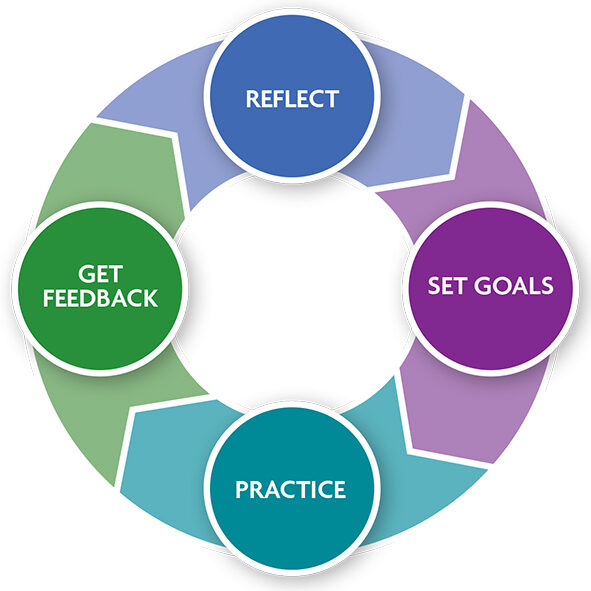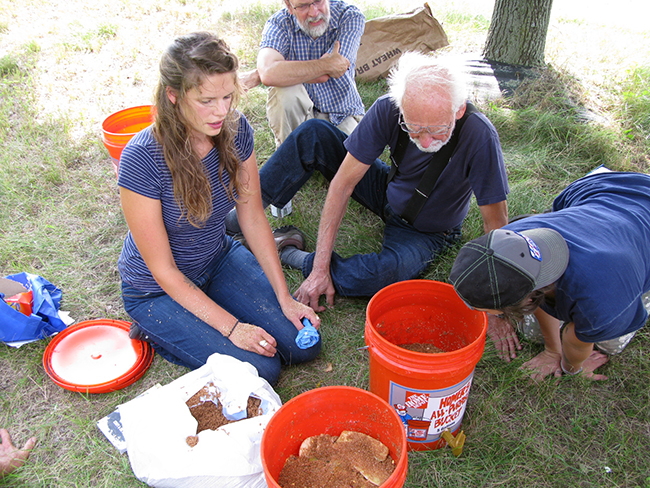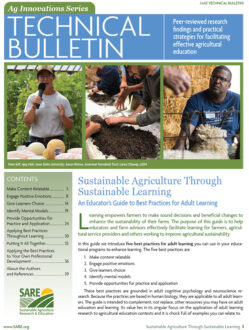Applying the Best Practices to Your Own Professional Development
You can have a positive impact on the adults with whom you work when you apply the five adult learning best practices in your teaching. You can also use these best practices as a guide for your own professional development as an educator. Two practices are particularly relevant to supporting your development: identifying your mental models related to adult teaching and learning, and employing deliberate practice in honing your “craft.”
Identifying Your Mental Models of Teaching and Learning
The mental models you have about adult teaching and learning can be a powerful underlying influence on how you teach, how you interact with learners, the expectations you have for learners and for yourself, and how you go about your own professional development as an adult educator. The nature of the mental models that guide you as an educator are reflected in your values, assumptions, expectations and preferences related to teaching and learning. Most often, you are likely unaware of the influence these attributes have on decisions you make and behaviors you exhibit as an adult educator. However, you can engage in activities that help to “surface” aspects of your mental models so that you can be aware of them. Articulating your mental models allows you to examine them and open them up to change.
Most often, you are likely unaware of the influence these attributes have on decisions you make and behaviors you exhibit as an adult educator. However, you can engage in activities that help to “surface” aspects of your mental models so that you can be aware of them.
Prompts like the ones in the box “How to Uncover Your Own Mental Models” can assist you in articulating aspects of your mental models. The wording for prompts will vary based on the nature of the mental models being explored. We have designed these prompts specifically for mental models about adult teaching and learning. Going through the prompts can be a particularly useful exercise if you find yourself grappling with a recurring challenge in your teaching or are somehow feeling “stuck” in your practice. At the end of the exercise, you may find yourself questioning long-held assumptions about your role as an educator or having new perspectives about farmers as adult learners. You can also go through the prompts as a way to guide your overall professional development as an adult educator. You may find that some of your responses become the catalyst to experiment with new methods or technologies, brainstorm with colleagues or seek out new resources.
A mental models articulation activity has two steps. The first step involves responding to prompts. The second step involves reviewing and reflecting on your responses. When you engage in the first step, you want to create conditions that quiet down the conscious thinking part of your brain so that you are more likely to express more tacit or hidden thoughts. Be spontaneous and non-judgmental when responding to prompts. Do not rehearse in your head your answer to a prompt before responding. Write down your initial response to each prompt. You can go back and add to a response if an additional idea occurs to you a bit later, but do not go back and change your initial response. Do not concern yourself with grammar or spelling, or with using complete sentences. Use single words or short phrases, or even a quick graphic image if it pops into your head.
How to Uncover Your Own Mental Models
Step 1. Complete each prompt as spontaneously as possible.
- My primary role as an educator in agriculture is ...
- I can tell farmers learn in my courses (or workshops, field days, etc.) because ...
- When farmers do not learn in my courses (or workshops, field days, etc.) it is mostly because ...
- The most important factor that determines whether a farmer makes changes to their operations after participating in one of my courses (or workshops, field days, etc.) is ...
- I am at my best as an educator when ...
- I am at my worst as an educator when ...
- Three things an educator should never do are ...
- Three things an adult learner should never do are ...
- The most challenging part of being an adult educator is ...
- The best way for me to become the best educator I can be is ...
- Three obstacles that may keep me from being the best educator I can be are ...
Step 2. Review and Reflection
Review each of your responses to the prompts and consider:
- Are you surprised by any of your responses? What surprised you and why?
- Did any of your responses make you feel uncomfortable? In what way?
- Did you learn anything about yourself as an educator?
- Based on what you learned about yourself, is there anything you could change in your craft as an educator? What could you change?
- Are there any resources that would benefit you as you try to make the change?
After responding to each prompt, move to the second step. Review your responses. Let yourself react to them. If you have been grappling with a specific challenge or have a specific goal in mind for enhancing your teaching, review your responses through that lens. Assess if any of your responses provide a new perspective or consideration related to that challenge or goal.
Go through the activity now, and then repeat it any time you would benefit from an increased self-awareness of the mental models that guide your craft as an educator.
Employing Deliberate Practice to Hone your Craft as an Adult Educator
The fifth best practice addresses the need for learners to practice knowledge and skills and then apply them to genuine problems. As an instructor, you can employ deliberate practice strategies to increase your knowledge and skills in teaching and learning so you are better prepared to meet the challenges inherent in helping farmers grow and make changes. As your knowledge and skills become second nature you will become more comfortable and flexible responding to unpredictable situations and more likely to recognize opportunities to experiment with novel approaches. The overall goal for deliberate practice is that you strive to become as knowledgeable, skilled and confident in strategies to facilitate adult learning as you are in your agricultural areas of specialty. And, like the need to keep up to date in your agricultural discipline, deliberate practice in adult teaching and learning is an ongoing endeavor.
As your knowledge and skills become second nature you will become more comfortable and flexible responding to unpredictable situations and more likely to recognize opportunities to experiment with novel approaches.
As described previously, the hallmarks of deliberate practice include setting performance goals that pose modest challenges; practicing for relatively brief periods and relying on your memory as you practice; keeping track of your performance, particularly errors; and obtaining feedback from a variety of sources. Based on these features, we have developed a Cycle of Deliberate Practice in Teaching and Learning that you can use to guide your deliberate practice efforts. The steps guide you to reflect, set goals, practice and get feedback (Figure 3).

Reflect
The cycle starts with reflecting on the areas in which you can improve as an instructor. A great place to start is with the self-knowledge you gained through the process of identifying your mental models about teaching and learning. That process often results in becoming more aware of aspects of your craft as an agricultural educator you would like to change. Feedback you receive about your efforts is also a valuable consideration during reflection.
Set Goals
Once you have identified what you would like to change, select one or two specific goals you can strive towards during a set time frame. For example, if you have limited experience with webinars and would like to become more skilled in conducting them, one goal could be to enhance your knowledge about the technical aspects of running a webinar over the next two months. A second goal could be to become proficient in using breakout rooms for small group discussions over the next four months. Set your goals so that they are a “comfortable challenge”—you want to achieve them with some effort, not abandon them because they are unreachable.
Practice
Set your goals so that they are a “comfortable challenge”—you want to achieve them with some effort, not abandon them because they are unreachable.
Depending on the type of goal you set, the practice step of the deliberate practice cycle may involve a variety of activities. If your goal is to gain more knowledge in a particular area, then you may need to review written or online resources, speak with others who have knowledge to share, or memorize key information and test your knowledge through self-quizzes and problem scenarios. For example, you would engage in this kind of practice if your goal was to become more knowledgeable about cognitive changes that occur as adults age in order to better serve older farmers. Another example is if you wanted to better understand something like the EPA’s Rules and Restrictions for Commenting on EPA Dockets to provide more effective consultation to farmers who wish to contribute public comments on proposed regulations.
If the nature of your goal is a physical or perceptual skill, such as creating eye-catching graphic slides or being able to speak common Hmong phrases during your interactions with Hmong farmers, your practice sessions would involve breaking down the skill into subcomponents, repeating until each component is mastered, gradually making the skill more complex and applying it in different settings. Having someone who is more skilled to coach you during this type of practice is ideal.
Regardless of the nature of your goal, practice needs to be focused, relatively brief and frequent.
If your goal is to become more proficient in a specific type of adult learning facilitation strategy, such as managing asynchronous online group discussions or leading farmers through a concept mapping activity during a face-to-face meeting, then the live classroom can become a practice setting. Be sure to practice the activity prior to the meeting, and during the meeting tell participants that you are trying to learn a new skill and would like to practice with them and get their feedback.
Regardless of the nature of your goal, practice needs to be focused, relatively brief and frequent. Even a few minutes of practice interspersed with your other professional activities can be very effective; just make sure during those few minutes you keep centered on the task, stay within the parameters of your practice goal and challenge your memory.
Get Feedback

The fourth part of the cycle involves getting feedback about your practice efforts, which you use to make modifications to your next cycle of deliberate practice. You can get feedback from two primary sources: from your performance of a task or activity itself and from other people.
Performance feedback. An example of feedback from your performance of a task would be if you made flashcards of common Hmong phrases and were correct for 70% of the cards. If you practiced phrases prior to an event but found yourself at a loss to remember some of them or mispronounced some when interacting with participants who spoke Hmong, then your performance would be a key source of feedback informing you that more practice was needed, particularly in more formal social settings. Another way to get feedback from your performance is to record yourself and then review the recording, either alone or with a coach or peer, making note of the extent to which you met your performance goals and what the focus of your next round of practice will be. People, either participants in an activity or observers of your practice, are also valuable sources of feedback.
Participant feedback. Obtain feedback from farmers who participate in your learning events both during the interactions as well as after. If you try out a new facilitation activity, ask for feedback from participants immediately after the activity, before transitioning to new content or another activity. Ask for specific feedback related to aspects of the facilitation you have been practicing. For example, during a webinar, before participants leave their small group breakout rooms, visit each room and ask, “Did you have any technical difficulties in the breakout room?” or “How did you use the provided prompts to manage your small group discussion?” Educators commonly use end-of-session surveys as an assessment tool, and these can include questions to obtain feedback about the effectiveness of specific facilitation strategies.
Observer feedback. Coaches and peers are important sources of feedback as well. Obtaining constructive, timely feedback from a coach is a proven strategy for performance improvement in many disciplines, including education. A coach can be anyone who is knowledgeable and/or skilled in the area in which you are practicing. A coach can objectively observe you, offer critiques of the processes you use to learn as well as the quality of your outcomes, make suggestions for improvement and model performance.
If your goal is to become more proficient in an adult learning facilitation strategy, you can obtain valuable coaching feedback from a colleague who, like you, is striving to improve their craft. Forming a partnership with one or more “feedback friends” can offer opportunities for mutually beneficial coaching feedback. Invite a feedback friend to sit in on a learning event you facilitate and to provide feedback. Return the favor and observe a learning event offered by the colleague. In addition to providing feedback to your colleague, you can identify the practices you see in action that relate to your own professional development goals and make note of ideas you want to try yourself or what you might do differently in a similar situation.
Continue the Cycle
To optimize the feedback part of the cycle, use both sources of feedback: your performance itself and other people. Keep a record of your deliberate practice activities: what you tried, how it worked and the reactions you received from others. This record becomes the basis for reflecting on and making decisions about what to focus on as you move into the next cycle of deliberate practice. This best practice, along with examining your mental models of teaching and learning, are two habits you can adopt in your ongoing professional development as an educator.
